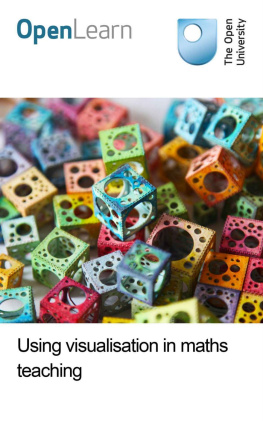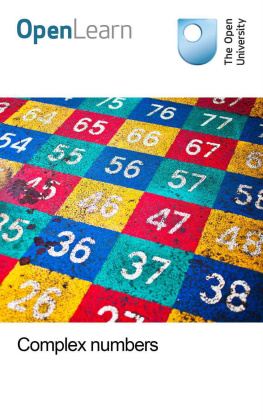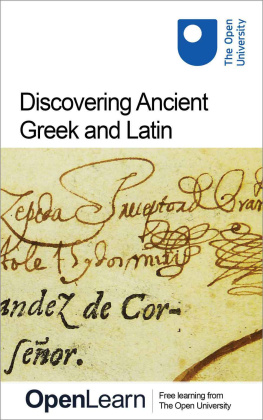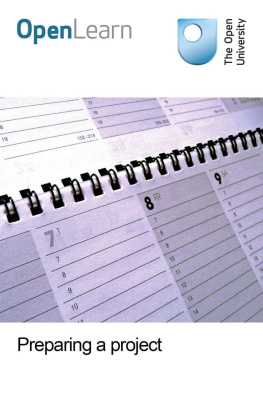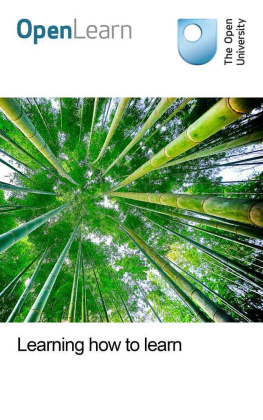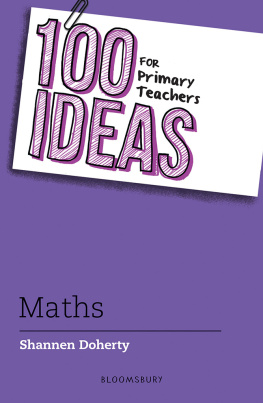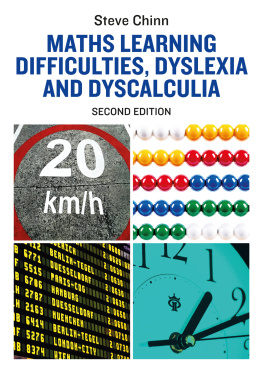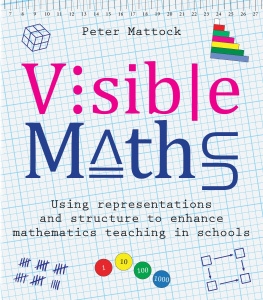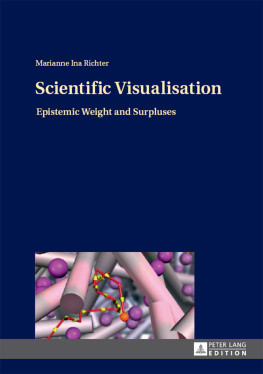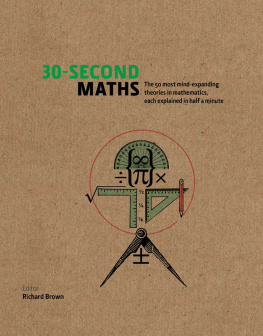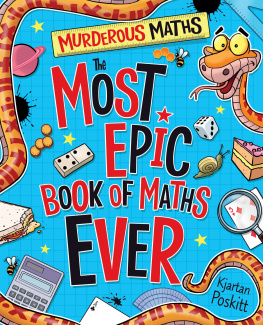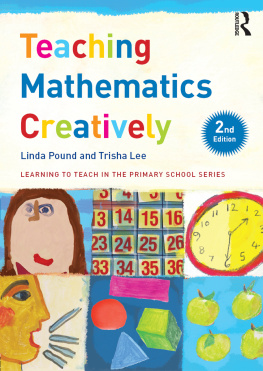University - Using visualisation in maths teaching
Here you can read online University - Using visualisation in maths teaching full text of the book (entire story) in english for free. Download pdf and epub, get meaning, cover and reviews about this ebook. year: 2016, publisher: The Open University, genre: Romance novel. Description of the work, (preface) as well as reviews are available. Best literature library LitArk.com created for fans of good reading and offers a wide selection of genres:
Romance novel
Science fiction
Adventure
Detective
Science
History
Home and family
Prose
Art
Politics
Computer
Non-fiction
Religion
Business
Children
Humor
Choose a favorite category and find really read worthwhile books. Enjoy immersion in the world of imagination, feel the emotions of the characters or learn something new for yourself, make an fascinating discovery.
- Book:Using visualisation in maths teaching
- Author:
- Publisher:The Open University
- Genre:
- Year:2016
- Rating:5 / 5
- Favourites:Add to favourites
- Your mark:
- 100
- 1
- 2
- 3
- 4
- 5
Using visualisation in maths teaching: summary, description and annotation
We offer to read an annotation, description, summary or preface (depends on what the author of the book "Using visualisation in maths teaching" wrote himself). If you haven't found the necessary information about the book — write in the comments, we will try to find it.
Using visualisation in maths teaching — read online for free the complete book (whole text) full work
Below is the text of the book, divided by pages. System saving the place of the last page read, allows you to conveniently read the book "Using visualisation in maths teaching" online for free, without having to search again every time where you left off. Put a bookmark, and you can go to the page where you finished reading at any time.
Font size:
Interval:
Bookmark:
About this free course
Find out more about studying with The Open University by visiting our online prospectus.
This version of the content may include video, images and interactive content that may not be optimised for your device.
You can experience this free course as it was originally designed on OpenLearn, the home of free learning from The Open University: http://www.open.edu/openlearn/education/using-visualisation-maths-teaching/content-section-0.
There youll also be able to track your progress via your activity record, which you can use to demonstrate your learning.
The Open University, Walton Hall, Milton Keynes, MK7 6AA
Copyright 2016 The Open University
Intellectual property
Unless otherwise stated, this resource is released under the terms of the Creative Commons Licence v4.0 http://creativecommons.org/licenses/by-nc-sa/4.0/deed.en_GB. Within that The Open University interprets this licence in the following way: www.open.edu/openlearn/about-openlearn/frequently-asked-questions-on-openlearn. Copyright and rights falling outside the terms of the Creative Commons Licence are retained or controlled by The Open University. Please read the full text before using any of the content.
We believe the primary barrier to accessing high-quality educational experiences is cost, which is why we aim to publish as much free content as possible under an open licence. If it proves difficult to release content under our preferred Creative Commons licence (e.g. because we cant afford or gain the clearances or find suitable alternatives), we will still release the materials for free under a personal end-user licence.
This is because the learning experience will always be the same high quality offering and that should always be seen as positive even if at times the licensing is different to Creative Commons.
When using the content you must attribute us (The Open University) (the OU) and any identified author in accordance with the terms of the Creative Commons Licence.
The Acknowledgements section is used to list, amongst other things, third party (Proprietary), licensed content which is not subject to Creative Commons licensing. Proprietary content must be used (retained) intact and in context to the content at all times.
The Acknowledgements section is also used to bring to your attention any other Special Restrictions which may apply to the content. For example there may be times when the Creative Commons Non-Commercial Sharealike licence does not apply to any of the content even if owned by us (The Open University). In these instances, unless stated otherwise, the content may be used for personal and non-commercial use.
We have also identified as Proprietary other material included in the content which is not subject to Creative Commons Licence. These are OU logos, trading names and may extend to certain photographic and video images and sound recordings and any other material as may be brought to your attention.
Unauthorised use of any of the content may constitute a breach of the terms and conditions and/or intellectual property laws.
We reserve the right to alter, amend or bring to an end any terms and conditions provided here without notice.
All rights falling outside the terms of the Creative Commons licence are retained or controlled by The Open University.
Head of Intellectual Property, The Open University
978-1-4730-1461-9 (.kdl)
978-1-4730-0693-5 (.epub)
This course looks at visualisation as it relates to mathematics, focusing upon how it can be used to improve learning. It will also identify ways in which to make more use of visualisation within the classroom.
Find out more about studying with The Open University by visiting our online prospectus.
After studying this course, you should be able to:
- demonstrate an engagement in a number of activities that involve visualisation and learning from personal experiences what it means
- understand the views of a well-known mathematics educator talking about visualisation and find out how personal views compare with those of some other secondary-school mathematics teachers
- identify some ways that visualising could be incorporated into a classroom and consider a number of resources that might be useful.
Imagery is a powerful force for perception and understanding. Being able to see something mentally is a common metaphor for understanding it. An image may be of some geometrical shape, or of a graph or diagram, or it may be some set of symbols or some procedure.
(Open University, 1988, p. 10)
This course uses the word visualisation synonymously with mental imagery. It happens as we articulate our thoughts and as we understand what we are doing.
Each of the four sections in this course should further develop your thinking on visualisation.
Starters
The main purpose of this course is to encourage you to form images and be aware of your experiences of visualisation.
What does visualisation mean?
In What does visualisation mean?, you will find quotes and readings about visualisation, followed by an opportunity to compare your views with those of some other secondary-school mathematics teachers. By the end of this section you should be confident that you know what visualisation means.
In the classroom
In the classroom describes a lesson in which visualising provides an introduction for the students, another worthwhile and interesting activity, and some ways to use resources to promote and stimulate visualisation.
Conclusion
The conclusion points to some recommended books that will be useful if you want to think a little more seriously about visualisation, as well as highlighting where visualisation is incorporated into the framework for mathematics school teaching.
We all have pictures in our heads but some people use them more than others.
Doing can often be the most powerful way to learn. Before discussing other people's thoughts on visualisation, it is probably worthwhile to spend some time exploring some visualisation activities with your colleagues. This should enable you to consider the next section from an experiential perspective.
Please click on the view document links below to explore a range of visualisation activities. Try at least two of these.
Click 'view document' below to download Arithmetic
View document
Click 'view document' below to download Circles
View document
Click 'view document' below to download Cutting paper
View document
Click 'view document' below to download Locus
View document
Click 'view document' below to download Multiples on grids
View document
Click 'view document' below to download Nets
View document
Click 'view document' below to download TV
View document
For each activity you attempt:
Try to do them in your heads before you look at anything.
Shut your eyes if it helps.
Try them individually and then talk in a group, but do not give any answers away help others to see what you can see.
No drawing, only talking.
No gesticulating either.
When you have experienced a number of visualisation activities, write down some of your own thoughts about visualisation and what it means.
Font size:
Interval:
Bookmark:
Similar books «Using visualisation in maths teaching»
Look at similar books to Using visualisation in maths teaching. We have selected literature similar in name and meaning in the hope of providing readers with more options to find new, interesting, not yet read works.
Discussion, reviews of the book Using visualisation in maths teaching and just readers' own opinions. Leave your comments, write what you think about the work, its meaning or the main characters. Specify what exactly you liked and what you didn't like, and why you think so.

